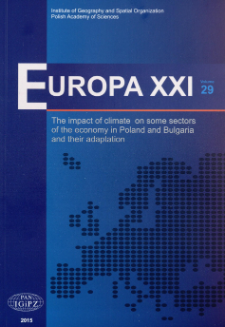- Wyszukaj w całym Repozytorium
- Piśmiennictwo i mapy
- Archeologia
- Baza Młynów
- Nauki przyrodnicze
Wyszukiwanie zaawansowane
Wyszukiwanie zaawansowane
Wyszukiwanie zaawansowane
Wyszukiwanie zaawansowane
Wyszukiwanie zaawansowane

Obiekt
Tytuł: The process of the spatial development of large cities in Poland and its adaptation to climate change: opportunities and threats
Inny tytuł:
Wydawca:
Miejsce wydania:
Opis:
29 cm ; Każdy numer posiada własny tytuł.
Typ obiektu:
Abstrakt:
This article draws attention to key aspects of the dynamic relationship between urbanisation and climatic conditioning, with particular account taken of the ventilating and cooling of cities and the influence of ecological continuity and connectivity between urban and open areas. Such phenomena are discussed in the context of the quality of life enjoyed by inhabitants of urbanised areas. The role of green infrastructure in shaping urban space from the point of view of the easing or amelioration of negative thermal phenomena is discussed, as is the influence of climatic conditions on the functioning of cities’ water systems. Reference is also made to demographic change in cities, given the major influence this has on inhabitants’ vulnerability to the negative impacts of developing heat islands, most especially in periods of severe and/or prolonged heatwaves.
Bibliografia:
1. Błażejczyk K., Kuchcik M., Milewski P., Dudek W., Kręcisz B., Szmyd J., Degórska B., Pałczyński C., 2014. Miejska wyspa ciepła w Warszawie, uwarunkowania klimatyczne i urbanistyczne. Warszawa: IGiPZ PAN, SEDNO Wydawnictwo Akademickie, 171 pp.
2. Degórska B., 2007. Key problems in the relation between the environment and spatial development in Poland. [in:] T. Marszał (ed.), European Spatial Research and Policy, vol. 14, no. 2, pp. 54-89.
3. Degórska B., 2014, Sensibility and adaptation big cities to climate change in the context of rising air temperature. National Spatial Planning Committee, Biuletyn KPZK PAN 254, pp. 27-46.
4. EEA 2012. Urban adaptation to climate change in Europe, Challenges and opportunities for cities together with supportive national and European policies. EEA Report 2, 2012, European Environment Agency, 143 pp.
5. Fischer E. M., Schar C., 2010. Consistent geographical patterns of changes in high-impact European heatwaves. Nature Geoscience, vol. 3, no. 6, pp. 398-403.
http://dx.doi.org/10.1038/ngeo866 -
6. Greiving S., 2011. Climate change and territorial effects on regions and local economies. ESPON Climate. ESPON & IRPUD, TU Dortmund, 55 pp.
7. IPCC 2007. Climate Change, Synthesis Report. IPCC, Geneva, Switzerland. 104 pp.
8. Kuchcik M., Degórski M., 2009. Heat and cold related mortality in the north-east of Poland as an example of the socio-economic effects of extreme hydrometeorological events in the Polish Lowland. Geographia Polonica, vol. 82, no. 1, pp. 69-78.
http://dx.doi.org/10.7163/GPol.2009.1.6 -
9. Raport Polska 2011. Gospodarka Społeczeństwo Regiony. Ministerstwo Rozwoju Regionalnego, Warszawa. http://www.mrr.gov.pl/rozwoj_regionalny/Ewaluacja_i_analizy/Raporty_o_rozwoju/Raporty_krajowe/Documents/Raport_Polska_2011.pdf za OECD Urban Policy Reviews, Poland 2011. OECD Publishing [11 September 2015].
10. WMO, 2013. The global climate 2001-2010. A decade of climate extremes. Summary Report, WMO-No. 1119, Geneva, 15 pp.
11. UN, 2007. World population growth will occur in urban areas of world. POP/757, New York: United Nations Report States, 198 pp.
Czasopismo/Seria/cykl:
Tom:
Strona pocz.:
Strona końc.:
Szczegółowy typ zasobu:
Format:
Rozmiar pliku 4,2 MB ; application/pdf
Identyfikator zasobu:
oai:rcin.org.pl:58783 ; 1429-7132 ; 10.7163/Eu21.2015.29.7
Źródło:
CBGiOŚ. IGiPZ PAN, sygn.: Cz.6406, Cz.6407 ; kliknij tutaj, żeby przejść
Język:
Język streszczenia:
Prawa:
Prawa zastrzeżone - dostęp nieograniczony
Zasady wykorzystania:
Digitalizacja:
Instytut Geografii i Przestrzennego Zagospodarowania Polskiej Akademii Nauk
Lokalizacja oryginału:
Dofinansowane ze środków:
Unia Europejska. Europejski Fundusz Rozwoju Regionalnego ; Program Operacyjny Innowacyjna Gospodarka, lata 2010-2014, Priorytet 2. Infrastruktura strefy B + R
Dostęp:
Kolekcje, do których przypisany jest obiekt:
- Repozytorium Cyfrowe Instytutów Naukowych > Kolekcje Partnerów > Instytut Geografii i Przestrzennego Zagospodarowania PAN > Publikacje pracowników i Wydawnictw
- Repozytorium Cyfrowe Instytutów Naukowych > Kolekcje Partnerów > Instytut Geografii i Przestrzennego Zagospodarowania PAN > Biblioteka Instytutu > Serie/Czasopisma/Cykle
- Repozytorium Cyfrowe Instytutów Naukowych > Piśmiennictwo > Czasopisma/Artykuły
Data ostatniej modyfikacji:
13 paź 2023
Data dodania obiektu:
9 maj 2016
Liczba pobrań / odtworzeń:
1095
Wszystkie dostępne wersje tego obiektu:
https://rcin.org.pl./publication/78634
Wyświetl opis w formacie RDF:
Wyświetl opis w formacie RDFa:
Wyświetl opis w formacie OAI-PMH:
Obiekty Podobne
Degórska, Bożena (1956– )
Affek, Andrzej Kowalska, Anna Regulska, Edyta Solon, Jerzy (1954– ) Degórska, Bożena (1956– ) Wolski, Jacek (1971– ) Degórski, Marek
Degórska, Bożena (1956– ) Degórski, Marek
Georgieva, Veska Kazandjiev, Valentin Degórski, Marek Błażejczyk, Krzysztof Kuchcik, Magdalena Degórska, Bożena
Banach, Anna Kozakiewicz, Anna Kozakiewicz, Michał Liro, Anna
Degórski, Marek
Degórska, Bożena (1956– ) Kurek, Aleksandra
Jäger, Bettina Szimonetta Buzási, Attila

 INSTYTUT ARCHEOLOGII I ETNOLOGII POLSKIEJ AKADEMII NAUK
INSTYTUT ARCHEOLOGII I ETNOLOGII POLSKIEJ AKADEMII NAUK
 INSTYTUT BADAŃ LITERACKICH POLSKIEJ AKADEMII NAUK
INSTYTUT BADAŃ LITERACKICH POLSKIEJ AKADEMII NAUK
 INSTYTUT BADAWCZY LEŚNICTWA
INSTYTUT BADAWCZY LEŚNICTWA
 INSTYTUT BIOLOGII DOŚWIADCZALNEJ IM. MARCELEGO NENCKIEGO POLSKIEJ AKADEMII NAUK
INSTYTUT BIOLOGII DOŚWIADCZALNEJ IM. MARCELEGO NENCKIEGO POLSKIEJ AKADEMII NAUK
 INSTYTUT BIOLOGII SSAKÓW POLSKIEJ AKADEMII NAUK
INSTYTUT BIOLOGII SSAKÓW POLSKIEJ AKADEMII NAUK
 INSTYTUT CHEMII FIZYCZNEJ PAN
INSTYTUT CHEMII FIZYCZNEJ PAN
 INSTYTUT CHEMII ORGANICZNEJ PAN
INSTYTUT CHEMII ORGANICZNEJ PAN
 INSTYTUT FILOZOFII I SOCJOLOGII PAN
INSTYTUT FILOZOFII I SOCJOLOGII PAN
 INSTYTUT GEOGRAFII I PRZESTRZENNEGO ZAGOSPODAROWANIA PAN
INSTYTUT GEOGRAFII I PRZESTRZENNEGO ZAGOSPODAROWANIA PAN
 INSTYTUT HISTORII im. TADEUSZA MANTEUFFLA POLSKIEJ AKADEMII NAUK
INSTYTUT HISTORII im. TADEUSZA MANTEUFFLA POLSKIEJ AKADEMII NAUK
 INSTYTUT JĘZYKA POLSKIEGO POLSKIEJ AKADEMII NAUK
INSTYTUT JĘZYKA POLSKIEGO POLSKIEJ AKADEMII NAUK
 INSTYTUT MATEMATYCZNY PAN
INSTYTUT MATEMATYCZNY PAN
 INSTYTUT MEDYCYNY DOŚWIADCZALNEJ I KLINICZNEJ IM.MIROSŁAWA MOSSAKOWSKIEGO POLSKIEJ AKADEMII NAUK
INSTYTUT MEDYCYNY DOŚWIADCZALNEJ I KLINICZNEJ IM.MIROSŁAWA MOSSAKOWSKIEGO POLSKIEJ AKADEMII NAUK
 INSTYTUT PODSTAWOWYCH PROBLEMÓW TECHNIKI PAN
INSTYTUT PODSTAWOWYCH PROBLEMÓW TECHNIKI PAN
 INSTYTUT SLAWISTYKI PAN
INSTYTUT SLAWISTYKI PAN
 SIEĆ BADAWCZA ŁUKASIEWICZ - INSTYTUT TECHNOLOGII MATERIAŁÓW ELEKTRONICZNYCH
SIEĆ BADAWCZA ŁUKASIEWICZ - INSTYTUT TECHNOLOGII MATERIAŁÓW ELEKTRONICZNYCH
 MUZEUM I INSTYTUT ZOOLOGII POLSKIEJ AKADEMII NAUK
MUZEUM I INSTYTUT ZOOLOGII POLSKIEJ AKADEMII NAUK
 INSTYTUT BADAŃ SYSTEMOWYCH PAN
INSTYTUT BADAŃ SYSTEMOWYCH PAN
 INSTYTUT BOTANIKI IM. WŁADYSŁAWA SZAFERA POLSKIEJ AKADEMII NAUK
INSTYTUT BOTANIKI IM. WŁADYSŁAWA SZAFERA POLSKIEJ AKADEMII NAUK




































